Mill news, updates and short reports
|
|
Fire at Bere Mill, Whitchurch
The
18th century Bere water mill has been gutted by a
severe fire, which
damaged the ground floor, first floor, and roof of
the farmhouse and mill.
Happily no one was hurt in the fire which broke out
on the evening of February 7 2018.
Hampshire
Fire and Rescue said crews had fought to save parts
of the historic building and would remain at the
scene damping down.
Bere Mill is now a family home that opens its
gardens to the public. It was the original paper
mill for Portals, the company which first supplied
notes to the Bank of England in 1718.
|

Hampshire Fire & Rescue Service |

SCAS HART |
|
HMG has written to the owner conveying our sadness
at this devastating event. In reply, the owner
reports that the mill mechanism has largely survived
the fire, and is now fully exposed, although the
cast iron ratchet mechanism has been cracked and the
wooden base burnt through. He hopes to be able to
restore this and get back to a working turbine.
|
|
Whitchurch Silk Mill News
|
|
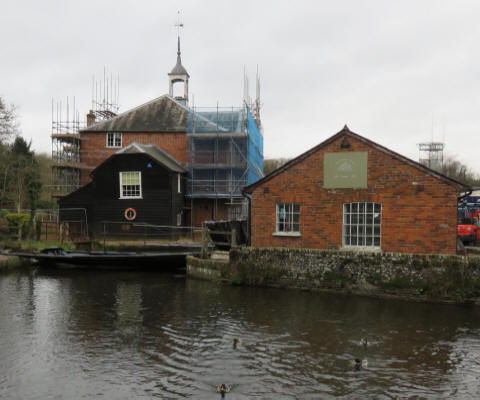 |
Here is some ongoing news from Whitchurch Silk Mill
about what the builders, Mountjoys, have been
doing. Permission to work on the Mill was granted
with an Environment Agency condition that none of
the scaffolding poles nor any builder could enter
the water.
The shop’s conversion into a new Welcome Building,
housing a café and brand-new shop, has begun with
the opening up of the back wall to create a wide
doorway which will take visitors out on to a new
boardwalk leading to the Mill building. A special
type of scaffolding has been erected which takes
into account the proximity of builders to
fast-moving water and also the protection of the
river and its banks.
|
|
Footings have been put in place, ready for the base
of a crane that will lift scaffolding beams to
create a platform across the roof, to support the
bell tower while it is being restored. The old
river bridges have been removed, some replaced with
temporary bridges, which will stay until ready for
installation of brand new ones.
A new exhibitions and events store cupboard has been
constructed above the waterwheel, in the space
formerly occupied by the carpenter’s workshop
display. A new doorway to the Tackler's Workshop
from the Weaving Shed is being constructed (right)
and the old stairlift and staircase into the
carpenter’s workshop have gone. Electrical work has
begun, with the old fuse boards being updated to
meet modern specifications.
|
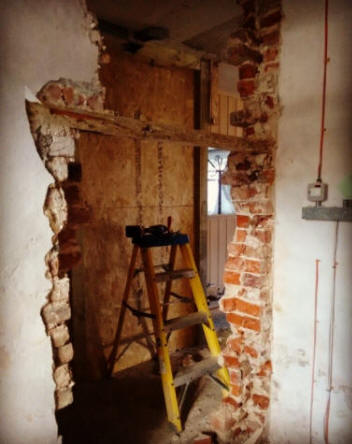 |
|
St Monans Windmill
Alan Cullen
|
|
On a recent visit to Scotland in December I paid a
visit to St Monans Windmill. It lies just a few
hundred yards east of the beautiful village of St
Monans, which overlooks the Firth of Forth. There
has been a windmill on this site since the 1550s as
it was used in the production of salt. The purpose
of the mill was to pump sea water up wooden pipes
into the panhouses. Using locally mined coal each
panhouse would have a furnace lit so the water would
evaporate and leave the salt. Wagon lines took the
salt to the local docks at Pittenweem and returned
with coal.
The salt industry was dogged by many problems of
fires in the coal mines, loss of the wagon lines,
and latterly the tax system which was altered so
that production was cheaper in England. Salt was a
highly sought-after commodity and was stored in
bonded buildings very much like whisky is today.
The life of the windmill pumping sea water lasted
till the salt pans ended in 1823. This left the
stump of the mill which was restored and reroofed in
the 1980’s. Its main use now is as a coastguard
look-out hence the replacement of sails by an aerial
to assist in radio contact. |
.jpg) |
St Monans Windmill with aerial mounted as if on the
windshaft.
Note the windows all around top for a better view
over the Forth.
The salt pans were housed in 9 buildings on the
raised beach below the windmill. These are the
remains of the mounds that the panhouses were built
on
.jpg) |
|
Editor’s note:
The Forth Basin, with its abundant coal supplies to
fire saltpan furnaces and its direct shipping routes
to Northern Europe, was Scotland’s main area of salt
production for some 800 years. The St Monans works
became the third largest salt producer in Fife.
The legacy of salt extraction remains mostly in a
series of place names alongside the River Forth
involving "pan" or "pans". The most well-known of
these is Prestonpans, where industrial salt
extraction continued until as recently as 1959.
|
|
Reigate Heath Windmill
Andy Fish |
|
Reigate Heath Windmill is a
grade 2* listed
post mill
situated on a golf course in Flanchford Road, just
off the A25 between Dorking and Reigate. It has
been restored and is used as a
chapel
and is thought to be the only windmill in the world
which is a consecrated church. |
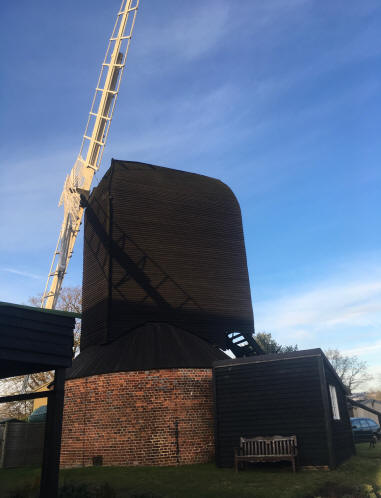 |
The present windmill was built about
1753 and was marked on maps dated 1753 and 1762. It
was last worked by wind in April 1862 and
in 1880, the roundhouse was converted into a chapel
known as ‘St Cross’ to cope with an influx of
parishioners to St Mary's Parish Church Reigate.
The first service took place on 14 September 1880.
In
1891 the mill was offered for sale, and in 1900 was
bought by Reigate Golf Club, who then leased the
mill back to the church. In 1926 a sail broke. New
sails were fitted in 1927 by Mr Morley, a
millwright
from
Crawley,
at a cost of £360, and a dummy
fantail
was fitted, a feature the mill never had during it
working life!
In 1943
the sails blew off again and were not replaced,
although repairs were made to the mill in 1949.
|
|
A survey of the mill carried out in
1952 revealed that although the roundhouse was in a
good condition, the mill was not. Recommendations
made included the replacement of the weather beam
which had been penetrated by rot to a depth of at
least 3 inches.
A survey of the mill carried out in 1952 revealed
that although the roundhouse was in a good
condition, the mill was not. Recommendations made
included the replacement of the weather beam which
had been penetrated by rot to a depth of at least 3
inches. |
|
Further restoration took place in
2002, including another set of new sails and repairs
and strengthening of the mill. The mill was awarded
third place in the 2003 Green Apple Awards and
on 22 September 1984 the first wedding to be
performed at the church was by Rev Thompson. The
newly-weds were Diana L Chiles and Andrew C
Bartlett.
Photos by
Andy Fish, December 2017.
|
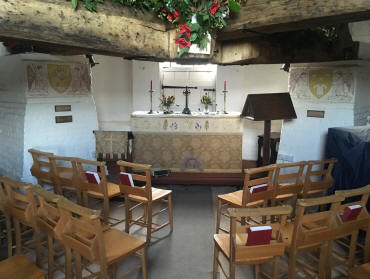
|
|
Replica Mill Wheel at Havant
Andy Fish
|
|
Further to the article in the Winter
2017
newsletter
here is an update on the works to the ‘Replica Mill
Wheel at Havant’.
After 30 years parts of the wheel became rotten and
it was in danger of collapsing. Following an
initiative by Postcode Publications Ltd, PMC
Construction & Development Ltd generously agreed to
sponsor the removal and restoration of the wheel by
their apprentices Joe Clapp and Billy Stillwell.
The new wheel was
unveiled
on 12 December 2017.
|
|
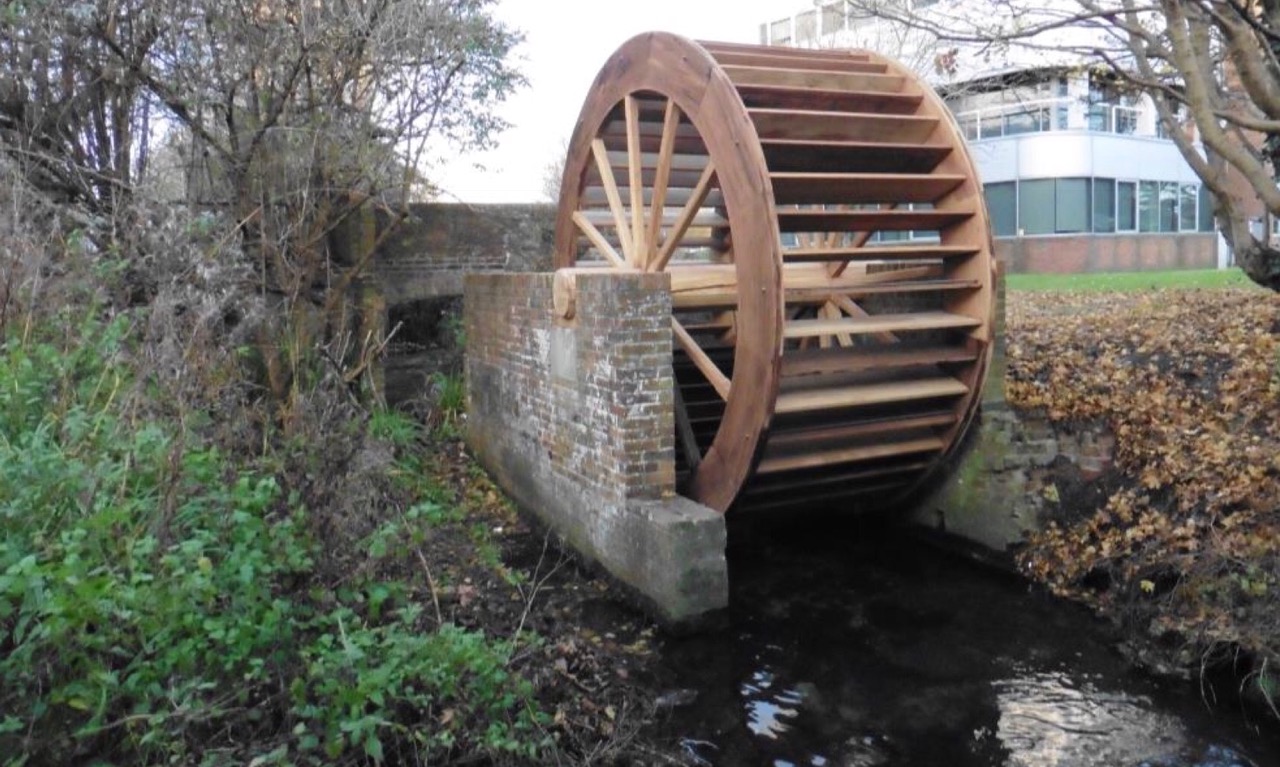
Ralph Cousins |
|
For more information see
http://thespring.co.uk/media/3245/81-havant-mills-final.pdf
Editor’s note:
Sadly
the wooden axle is resting directly on the brickwork
and if the water normally flows at the level shown
in the photo then the wheel makes no contact with
the water at all.
|
